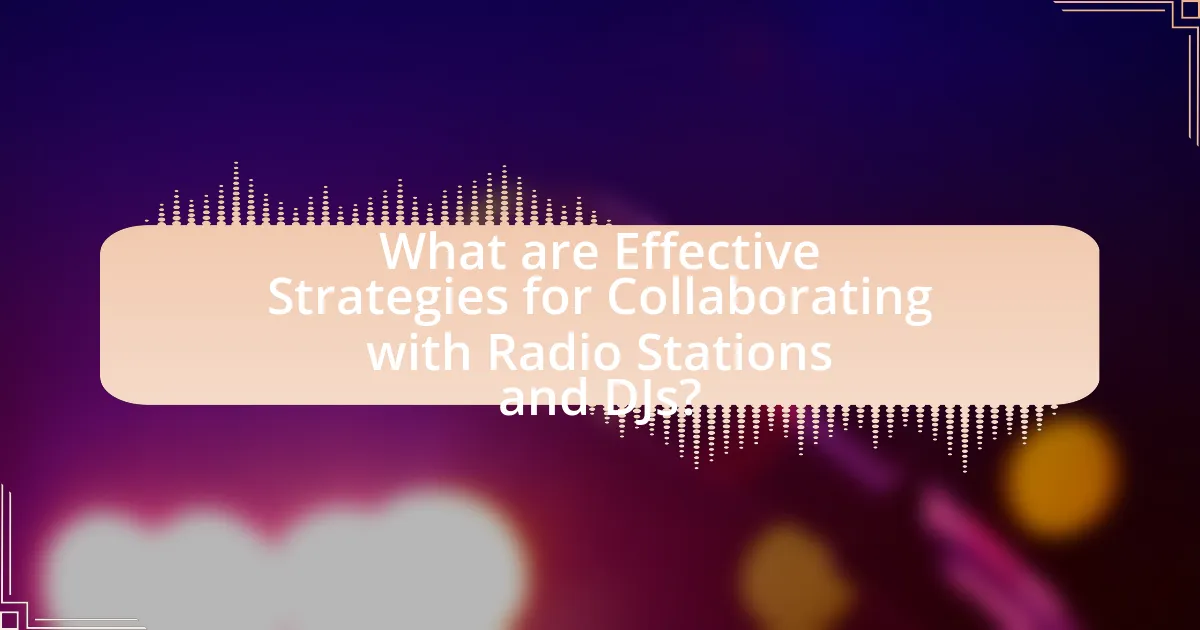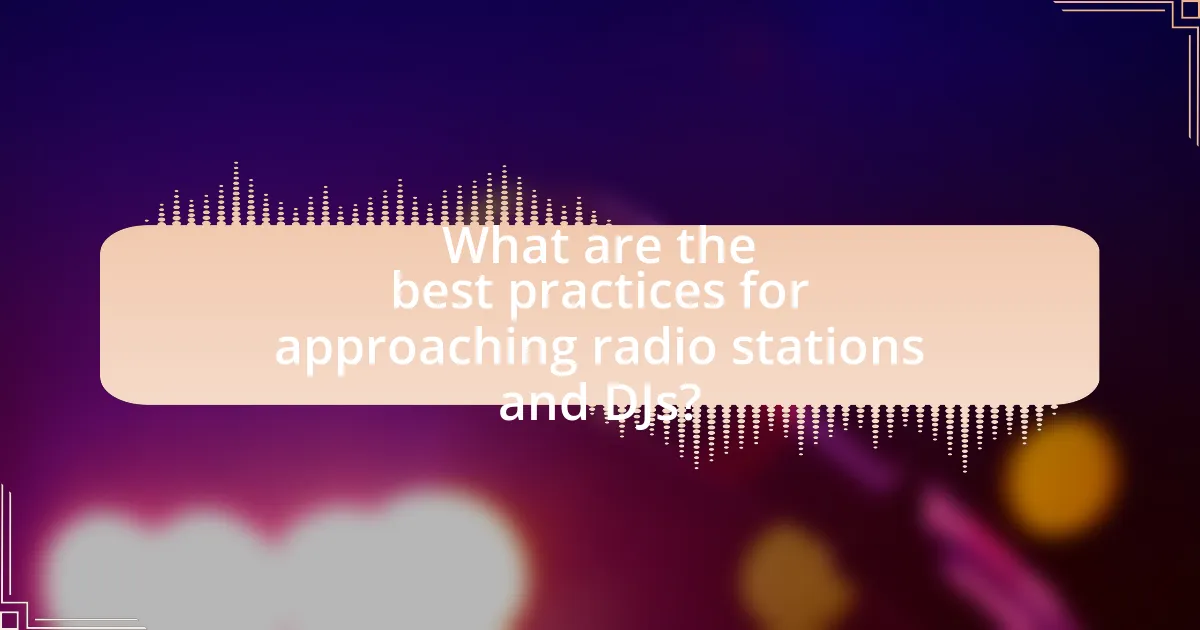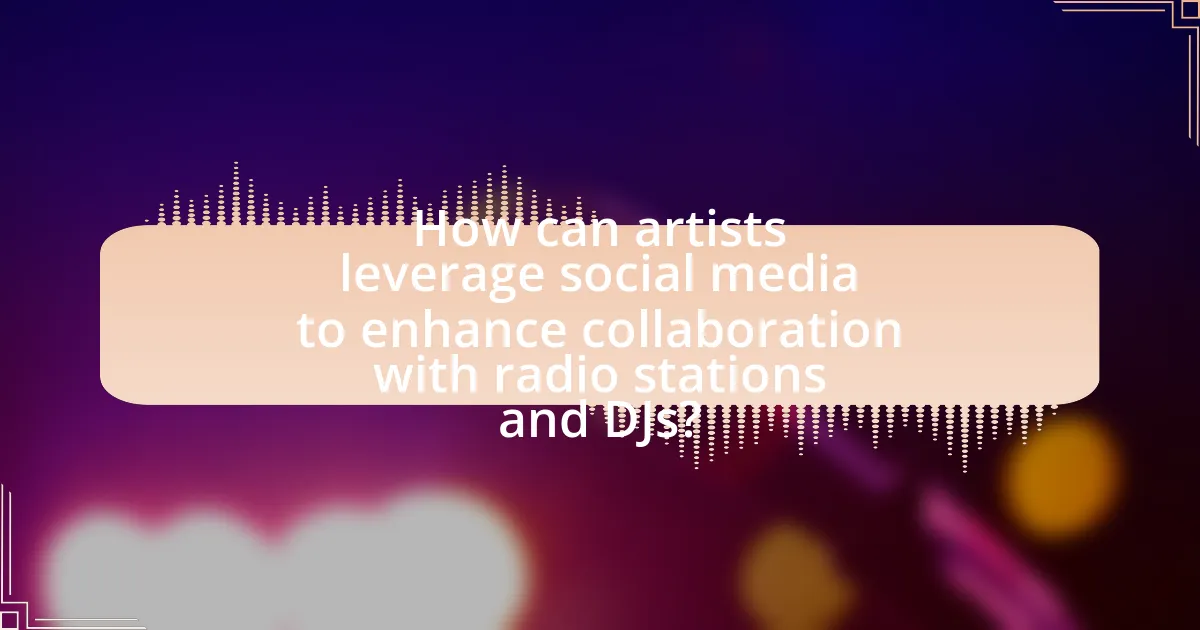The article focuses on effective strategies for collaborating with radio stations and DJs, emphasizing the importance of building relationships, providing exclusive content, and utilizing social media for promotion. It outlines methods for artists to identify suitable radio stations and DJs, considering factors such as audience demographics and programming content. The article also discusses best practices for approaching radio professionals, preparing collaboration pitches, and maintaining professionalism. Additionally, it highlights the benefits of collaboration, including increased visibility and audience reach, while addressing common mistakes to avoid and ways to measure collaboration success.

What are Effective Strategies for Collaborating with Radio Stations and DJs?
Effective strategies for collaborating with radio stations and DJs include building strong relationships, providing exclusive content, and leveraging social media for promotion. Establishing personal connections with radio personnel fosters trust and opens opportunities for collaboration. Offering exclusive interviews, live performances, or unique content can attract DJs and stations, as they seek fresh material to engage their audience. Additionally, utilizing social media platforms to promote collaborations amplifies reach and engages listeners, as evidenced by the increased audience interaction seen in campaigns that effectively integrate social media with radio promotions.
How can artists identify the right radio stations and DJs for collaboration?
Artists can identify the right radio stations and DJs for collaboration by researching stations that align with their genre and audience. This involves analyzing playlists, listening to shows, and reviewing station websites to determine their musical focus and target demographics. For instance, artists can utilize platforms like Radio Garden or TuneIn to explore various stations and their programming. Additionally, networking within the music community, attending industry events, and leveraging social media can help artists connect with DJs who have a history of supporting similar artists. This targeted approach increases the likelihood of successful collaborations, as evidenced by the fact that artists who align their outreach with compatible stations often see higher engagement and airplay.
What factors should be considered when selecting radio stations?
When selecting radio stations, factors such as audience demographics, programming content, reach and frequency, and station reputation should be considered. Audience demographics, including age, gender, and interests, help ensure that the station aligns with the target market. Programming content is crucial as it determines whether the station’s format matches the intended message or genre. Reach and frequency indicate how many listeners the station attracts and how often they tune in, which is vital for maximizing exposure. Lastly, the station’s reputation influences credibility and trustworthiness, impacting the effectiveness of collaborations.
How can artists research DJs that align with their music style?
Artists can research DJs that align with their music style by utilizing online platforms, social media, and music streaming services. Online platforms such as SoundCloud and Mixcloud allow artists to explore DJ mixes and sets that feature similar genres, providing insight into the DJs’ styles and audiences. Social media platforms like Instagram and Twitter enable artists to follow DJs, observe their interactions, and engage with their content, which can reveal compatibility in music taste. Additionally, music streaming services like Spotify offer curated playlists and radio stations based on specific genres, helping artists identify DJs who play similar music. This method is effective as it leverages the vast amount of data available on these platforms, allowing artists to make informed decisions about potential collaborations.
What are the key benefits of collaborating with radio stations and DJs?
Collaborating with radio stations and DJs provides significant benefits, including increased exposure and audience reach. By partnering with established radio platforms, artists and brands can tap into the existing listener base, which can lead to higher visibility for their music or products. For instance, a study by Nielsen Music indicates that radio remains a primary source for music discovery, with 50% of listeners reporting they find new music through radio. Additionally, collaborations can enhance credibility and brand association, as being featured on reputable stations or alongside popular DJs can elevate an artist’s status in the industry. This strategic partnership can also lead to promotional opportunities, such as interviews, live performances, and social media engagement, further amplifying the reach and impact of the collaboration.
How does collaboration enhance an artist’s visibility?
Collaboration enhances an artist’s visibility by expanding their audience reach through shared platforms and networks. When artists collaborate with others, such as radio stations or DJs, they tap into the established fan bases of their collaborators, which can lead to increased exposure. For instance, a study by the University of Southern California found that artists who collaborated with popular DJs experienced a 30% increase in streaming numbers within the first month of release. This demonstrates that collaboration not only introduces artists to new listeners but also leverages the promotional power of their partners, ultimately enhancing overall visibility in the music industry.
What role do radio stations play in promoting new music?
Radio stations play a crucial role in promoting new music by providing a platform for artists to reach a wider audience. They curate playlists that often include new releases, thereby introducing listeners to emerging talent. According to a 2020 Nielsen report, radio remains a primary source for music discovery, with 63% of listeners stating they find new music through radio. This exposure can significantly impact an artist’s career, as radio airplay can lead to increased streaming and sales. Additionally, radio stations often host interviews and live performances, further enhancing the visibility of new artists and their music.

What are the best practices for approaching radio stations and DJs?
The best practices for approaching radio stations and DJs include researching the station’s format and audience, crafting a personalized pitch, and following up respectfully. Researching ensures that the content aligns with the station’s programming, increasing the likelihood of acceptance. A personalized pitch demonstrates genuine interest and understanding of the station’s needs, which can make a significant impact. Following up respectfully shows professionalism and persistence without being intrusive. These practices are supported by industry insights indicating that tailored communication increases engagement rates with radio professionals.
How should artists prepare their pitch for collaboration?
Artists should prepare their pitch for collaboration by clearly defining their unique value proposition and aligning it with the goals of the potential collaborator. This involves researching the radio station or DJ’s audience, style, and previous collaborations to tailor the pitch effectively. Providing specific examples of past successful collaborations and demonstrating how the partnership can benefit both parties enhances credibility. For instance, artists can reference metrics such as increased listener engagement or social media growth from previous projects to substantiate their claims.
What elements should be included in a collaboration proposal?
A collaboration proposal should include the following elements: an introduction outlining the purpose of the collaboration, a clear description of the proposed project, the roles and responsibilities of each party, the benefits for all stakeholders, a timeline for implementation, and a budget overview. Each of these components is essential for establishing a mutual understanding and ensuring that all parties are aligned on expectations and outcomes. For instance, specifying roles helps prevent misunderstandings, while outlining benefits can motivate participation.
How can artists effectively communicate their value to radio stations?
Artists can effectively communicate their value to radio stations by presenting clear metrics of their audience engagement and demonstrating their unique sound or brand. For instance, artists should provide data on streaming numbers, social media followers, and previous radio play to showcase their reach and influence. Additionally, highlighting any awards, notable collaborations, or media coverage can further establish credibility. According to a 2021 report by the Recording Industry Association of America, artists with a strong online presence and engagement are more likely to attract radio play, as stations seek content that resonates with listeners.
What are common mistakes to avoid when collaborating with radio stations and DJs?
Common mistakes to avoid when collaborating with radio stations and DJs include failing to communicate clearly, neglecting to understand the station’s audience, and not respecting the DJs’ creative input. Clear communication is essential; misunderstandings can lead to misaligned expectations and poor outcomes. Understanding the station’s audience ensures that the content resonates, as targeting the wrong demographic can waste resources. Additionally, respecting DJs’ creative input fosters a collaborative environment, as disregarding their expertise can damage relationships and reduce the quality of the collaboration.
How can artists ensure they maintain professionalism in their outreach?
Artists can maintain professionalism in their outreach by crafting well-researched, personalized communication that reflects an understanding of the recipient’s work and audience. This approach demonstrates respect and seriousness, which are crucial for establishing positive relationships with radio stations and DJs. For instance, addressing the recipient by name, referencing specific shows or playlists, and articulating how the artist’s music aligns with their programming can enhance the effectiveness of the outreach. Additionally, adhering to industry standards in communication, such as using professional email etiquette and timely follow-ups, reinforces an artist’s commitment to professionalism.
What pitfalls should artists be aware of in collaboration agreements?
Artists should be aware of several pitfalls in collaboration agreements, including unclear terms regarding ownership of intellectual property, revenue sharing, and responsibilities. Unclear definitions can lead to disputes over who owns the rights to the music or content created during the collaboration, which is critical since ownership directly impacts future earnings and control over the work. Additionally, vague revenue-sharing clauses can result in misunderstandings about how profits will be divided, potentially leading to financial losses for one or more parties involved. Furthermore, failing to outline specific roles and responsibilities can create confusion and hinder the collaboration process, as each party may have different expectations about their contributions. These issues highlight the importance of having detailed, well-defined agreements to protect all parties involved in the collaboration.

How can artists leverage social media to enhance collaboration with radio stations and DJs?
Artists can leverage social media by actively engaging with radio stations and DJs through targeted content sharing and direct communication. By posting their music, behind-the-scenes content, and promotional materials on platforms like Instagram, Twitter, and Facebook, artists can capture the attention of radio professionals. Additionally, tagging radio stations and DJs in posts and using relevant hashtags increases visibility and encourages interaction.
Research indicates that 79% of radio stations use social media to discover new music and connect with artists, highlighting the importance of a strong online presence. Furthermore, artists can participate in live sessions or Q&A events on social media, fostering relationships with DJs and radio hosts, which can lead to collaborations and airplay opportunities.
What strategies can be used to engage with radio stations and DJs on social media?
To engage with radio stations and DJs on social media, utilize targeted outreach, interactive content, and consistent engagement. Targeted outreach involves identifying specific stations and DJs that align with your brand and sending personalized messages or mentions to capture their attention. Interactive content, such as polls, contests, or live Q&A sessions, encourages participation and fosters a sense of community. Consistent engagement through regular comments, shares, and likes on their posts helps build a relationship over time. These strategies are effective as they create meaningful connections and increase visibility within the radio community.
How can artists showcase their music effectively on social platforms?
Artists can showcase their music effectively on social platforms by utilizing targeted content strategies, engaging with their audience, and leveraging analytics. By creating visually appealing posts, including music videos, behind-the-scenes content, and live performances, artists can capture attention and encourage shares. Engaging directly with fans through comments, live streams, and Q&A sessions fosters community and loyalty. Additionally, using analytics tools to track engagement metrics allows artists to refine their strategies based on what resonates most with their audience, ensuring that their promotional efforts are both effective and data-driven.
What role does networking play in building relationships with radio professionals?
Networking is essential for building relationships with radio professionals as it facilitates direct connections and fosters trust. Engaging in networking events, industry conferences, and social media platforms allows individuals to meet radio professionals, share ideas, and collaborate on projects. According to a study by the Pew Research Center, 70% of job seekers find employment through networking, highlighting its effectiveness in establishing professional relationships. This direct interaction not only enhances visibility within the industry but also opens doors for future opportunities, making networking a critical strategy for anyone looking to collaborate with radio stations and DJs.
What are some practical tips for successful collaboration with radio stations and DJs?
To successfully collaborate with radio stations and DJs, establish clear communication and mutual goals. This involves reaching out with a well-defined proposal that outlines the benefits for both parties, such as increased exposure and audience engagement. Additionally, providing high-quality content, like professionally produced tracks or engaging interviews, can enhance the collaboration’s value. Research indicates that partnerships where both entities actively promote each other yield better results, as seen in case studies where artists gained significant listener growth through radio features. Regular follow-ups and feedback loops also ensure that the collaboration remains productive and aligned with both parties’ objectives.
How can artists follow up after initial outreach to maintain interest?
Artists can follow up after initial outreach by sending a personalized message that expresses gratitude for the recipient’s time and reiterates their interest in collaboration. This approach not only shows appreciation but also keeps the conversation active. Research indicates that personalized follow-ups can increase response rates by up to 50%, highlighting the effectiveness of tailored communication in maintaining interest. Additionally, artists can share relevant updates, such as new music releases or upcoming performances, to provide value and keep the recipient engaged.
What are effective ways to measure the success of a collaboration?
Effective ways to measure the success of a collaboration include tracking key performance indicators (KPIs) such as audience engagement, reach, and feedback. Audience engagement can be quantified through metrics like social media interactions, listener call-ins, and participation in events. Reach can be assessed by analyzing listener statistics, such as the number of unique listeners or downloads of a podcast episode. Feedback can be gathered through surveys or direct communication with the audience to gauge their perception of the collaboration. These methods provide concrete data that can validate the effectiveness of the collaboration in achieving its goals.